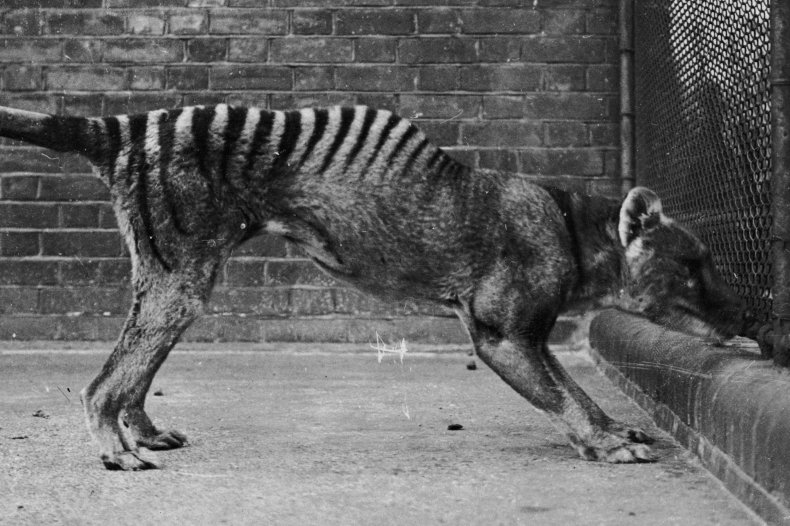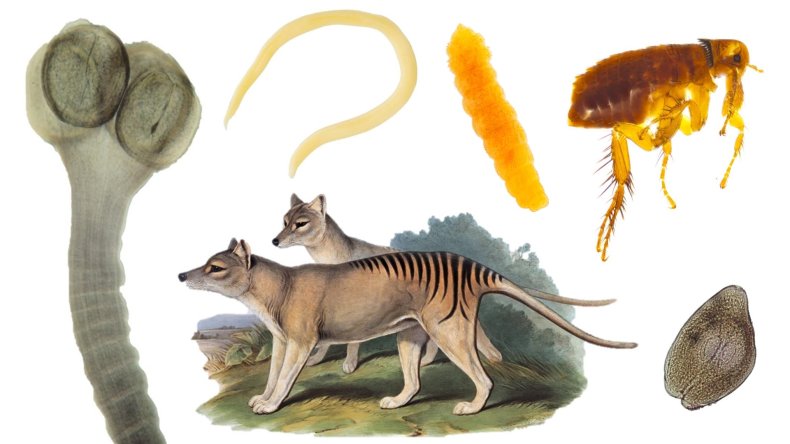BY ARISTOS GEORGIOU
ON 3/3/23
Parasites that once feasted on the extinct Tasmanian tiger, otherwise known as the Thylacine, surprisingly still exist today.
One of these parasites, a species of flea, has managed to survive even though the last known Tasmanian tiger died in 1936.
Thylacines were native to the Australian mainland, as well as the islands of Tasmania and New Guinea. The iconic species first appeared around 4 million years ago and was the largest living carnivorous marsupial before it vanished, driven in part by human persecution.
While the last known thylacine died at a zoo in Tasmania in 1936, it was not until 1982 that the International Union for Conservation of Nature declared the species extinct.

Parasites that once feasted on the extinct Tasmanian tiger, otherwise known as the Thylacine, surprisingly still exist today.
One of these parasites, a species of flea, has managed to survive even though the last known Tasmanian tiger died in 1936.
Thylacines were native to the Australian mainland, as well as the islands of Tasmania and New Guinea. The iconic species first appeared around 4 million years ago and was the largest living carnivorous marsupial before it vanished, driven in part by human persecution.
While the last known thylacine died at a zoo in Tasmania in 1936, it was not until 1982 that the International Union for Conservation of Nature declared the species extinct.

A Thylacine in captivity circa 1930. These animals are thought to be extinct—the last known Tasmanian tiger died in 1936.
At the time, international standards dictated that 50 years must pass with no confirmed records of an animal before it could officially be declared extinct.
Given that scientists know relatively little about the Thylacine itself, knowledge of its parasites is surprisingly robust.
"Fortunately for us, the last Thylacine died relatively recently, in 1936, and over the century or so prior to that, support for science and natural history in Australia grew steadily. That meant that there were scientists and museum curators out collecting specimens, including Thylacines and their parasites," Mackenzie Kwak, a parasitologist at Hokkaido University in Japan, told Newsweek.
"Many of those specimens are still protected in museums today, which gives researchers like me the opportunity to learn more about them and share that information with the public and other scientists."
Kwak, who was born and raised in Australia, said he got "hooked" on parasitology in his last year of pursuing his bachelor's degree and has been researching parasites ever since.
"I think almost every Aussie—myself included—has an innate fascination with the Thylacine, not only because it's an Australian icon but also because it was such a large and spectacular animal."
Three parasite species have been recorded from the Thylacine: the aforementioned flea, a roundworm and a tapeworm.
"Interestingly though, the roundworm and tapeworm were accidental infections, with the roundworms originating from a hapless pigeon which was caught and eaten by a Thylacine in the London Zoo and the tapeworm likely having been contracted by a Thylacine eating scats of a Tasmanian devil," Kwak said.
"However, the Thylacine probably had many other parasites if their relatives, the quolls and Tasmanian devils, are any indicator. Sadly though, any chance of understanding these other mystery parasites probably vanished when the Thylacine became extinct," he said.
At the time, international standards dictated that 50 years must pass with no confirmed records of an animal before it could officially be declared extinct.
Given that scientists know relatively little about the Thylacine itself, knowledge of its parasites is surprisingly robust.
"Fortunately for us, the last Thylacine died relatively recently, in 1936, and over the century or so prior to that, support for science and natural history in Australia grew steadily. That meant that there were scientists and museum curators out collecting specimens, including Thylacines and their parasites," Mackenzie Kwak, a parasitologist at Hokkaido University in Japan, told Newsweek.
"Many of those specimens are still protected in museums today, which gives researchers like me the opportunity to learn more about them and share that information with the public and other scientists."
Kwak, who was born and raised in Australia, said he got "hooked" on parasitology in his last year of pursuing his bachelor's degree and has been researching parasites ever since.
"I think almost every Aussie—myself included—has an innate fascination with the Thylacine, not only because it's an Australian icon but also because it was such a large and spectacular animal."
Three parasite species have been recorded from the Thylacine: the aforementioned flea, a roundworm and a tapeworm.
"Interestingly though, the roundworm and tapeworm were accidental infections, with the roundworms originating from a hapless pigeon which was caught and eaten by a Thylacine in the London Zoo and the tapeworm likely having been contracted by a Thylacine eating scats of a Tasmanian devil," Kwak said.
"However, the Thylacine probably had many other parasites if their relatives, the quolls and Tasmanian devils, are any indicator. Sadly though, any chance of understanding these other mystery parasites probably vanished when the Thylacine became extinct," he said.

An illustration of the thylacine and its parasites. The burrowing flea (Uropsylla tasmanica) is the only natural parasite of the Thylacine that still exists today.
MACKENZIE KWAK/J. GOULD
The parasites of the Tasmanian tiger likely did not cause too much harm to their host, according to Kwak.
"In most cases, we find that parasites which have co-evolved with their hosts over a long period of time typically converge on a fairly amicable existence with their host," he said. "Increasingly, we are also realizing that parasites can actually help to train the host's immune system which can help to reduce the risk of allergies and autoimmune diseases. So, parasites may have even benefited the Thylacine in their own small way."
The burrowing flea (Uropsylla tasmanica) is the only natural parasite of the Thylacine that still persists today. It survives in Australia on quolls and Tasmanian devils—two other types of carnivorous marsupials.
Kwak said it's surprising that this flea still exists given that it was specialized to live on the Thylacine.
"Very often when a species goes extinct, its host-specific parasites become extinct as well—a process we call an extinction cascade. So, to have the burrowing flea alive and well today is remarkable, especially when you consider that the quolls and Tasmanian devils that it survives on are actually quite distantly related to the Thylacine and belong to an entirely different family of marsupials," he said.
"The flea seems to have 'hedged its bets' by parasitizing a range of carnivorous marsupials—a quirk of its ecology, but a very lucky quirk nonetheless!"
The burrowing flea had a "very unique" relationship with the Thylacine, according to Kwak.
"Unlike other fleas, the larvae of burrowing fleas are also parasitic and embed themselves within the skin of the host, though the adults are much like the typical fleas most people know and loath," he said. "They would have lived within the fur of the Thylacine, taking small blood meals from their host."
Almost a century since the last known Thylacine died, some scientists have started working on the "de-extinction" of the species. If these efforts, which are utilizing advanced gene-editing technology, turn out to be successful, there will be significant implications for the burrowing flea.
"If the Thylacine were to be resurrected through de-extinction science, sooner or later conservationists would push for it to be rewilded into Tasmania so that it could once again fulfill its ecological functions," Kwak said.
"Given that the burrowing flea and its remaining hosts are already widespread in Tasmania, it would really only be a matter of time until the fleas 'rewilded' themselves back onto the Thylacine. Perhaps by 2040, Tasmania may again have the burrowing fleas and Thylacine together back in the ecosystem just as they were 200 years ago in 1840!"
The parasites of the Tasmanian tiger likely did not cause too much harm to their host, according to Kwak.
"In most cases, we find that parasites which have co-evolved with their hosts over a long period of time typically converge on a fairly amicable existence with their host," he said. "Increasingly, we are also realizing that parasites can actually help to train the host's immune system which can help to reduce the risk of allergies and autoimmune diseases. So, parasites may have even benefited the Thylacine in their own small way."
The burrowing flea (Uropsylla tasmanica) is the only natural parasite of the Thylacine that still persists today. It survives in Australia on quolls and Tasmanian devils—two other types of carnivorous marsupials.
Kwak said it's surprising that this flea still exists given that it was specialized to live on the Thylacine.
"Very often when a species goes extinct, its host-specific parasites become extinct as well—a process we call an extinction cascade. So, to have the burrowing flea alive and well today is remarkable, especially when you consider that the quolls and Tasmanian devils that it survives on are actually quite distantly related to the Thylacine and belong to an entirely different family of marsupials," he said.
"The flea seems to have 'hedged its bets' by parasitizing a range of carnivorous marsupials—a quirk of its ecology, but a very lucky quirk nonetheless!"
The burrowing flea had a "very unique" relationship with the Thylacine, according to Kwak.
"Unlike other fleas, the larvae of burrowing fleas are also parasitic and embed themselves within the skin of the host, though the adults are much like the typical fleas most people know and loath," he said. "They would have lived within the fur of the Thylacine, taking small blood meals from their host."
Almost a century since the last known Thylacine died, some scientists have started working on the "de-extinction" of the species. If these efforts, which are utilizing advanced gene-editing technology, turn out to be successful, there will be significant implications for the burrowing flea.
"If the Thylacine were to be resurrected through de-extinction science, sooner or later conservationists would push for it to be rewilded into Tasmania so that it could once again fulfill its ecological functions," Kwak said.
"Given that the burrowing flea and its remaining hosts are already widespread in Tasmania, it would really only be a matter of time until the fleas 'rewilded' themselves back onto the Thylacine. Perhaps by 2040, Tasmania may again have the burrowing fleas and Thylacine together back in the ecosystem just as they were 200 years ago in 1840!"
No comments:
Post a Comment